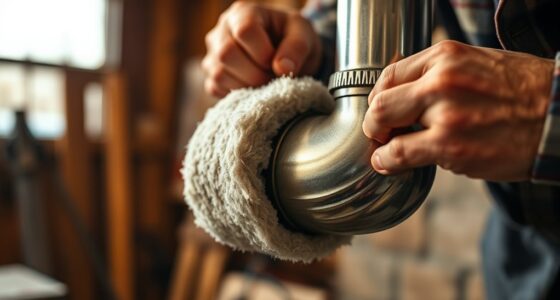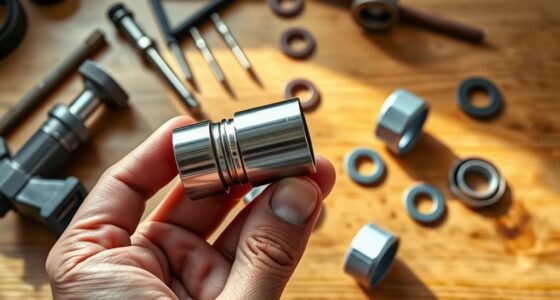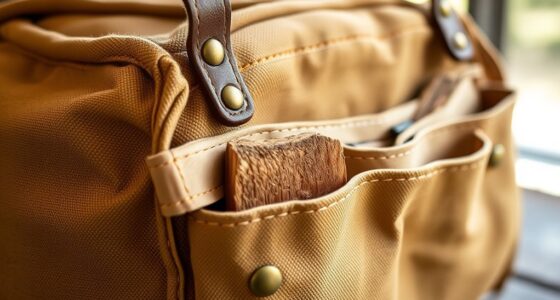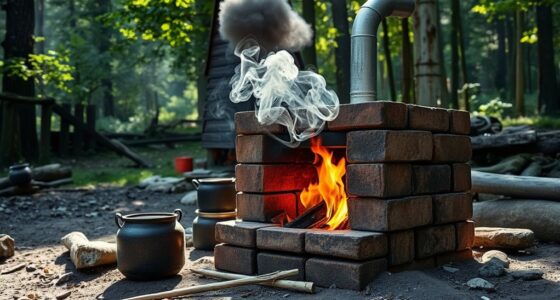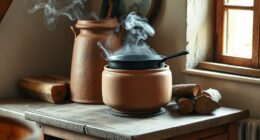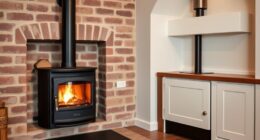To upcycle an antique wood stove into furniture, start by thoroughly cleaning and inspecting it for rust, dirt, and damage. Safely remove any hazardous residues like old paint or creosote, and reinforce weak spots with welding if needed. Sandblast or smooth the surface for a polished look, then add decorative touches or functional elements like a top surface, shelves, or legs. With proper sealing and safety checks, your transformed stove can become a unique table, centerpiece, or storage piece that adds character to your space. Keep exploring to learn more.
Key Takeaways
- Thoroughly clean and remove rust, dirt, and old paint using wire brushes, rust removers, or sandblasting.
- Reinforce or repair any structural damage, welding weak spots if necessary, to ensure safety and stability.
- Apply heat-resistant finishes and customize with added legs, shelving, or a top surface to convert into functional furniture.
- Seal internal chambers and remove hazardous residues to ensure safety, especially if the piece is used indoors.
- Enhance aesthetics with paint or decorative touches, transforming the stove into a striking table, storage unit, or centerpiece.
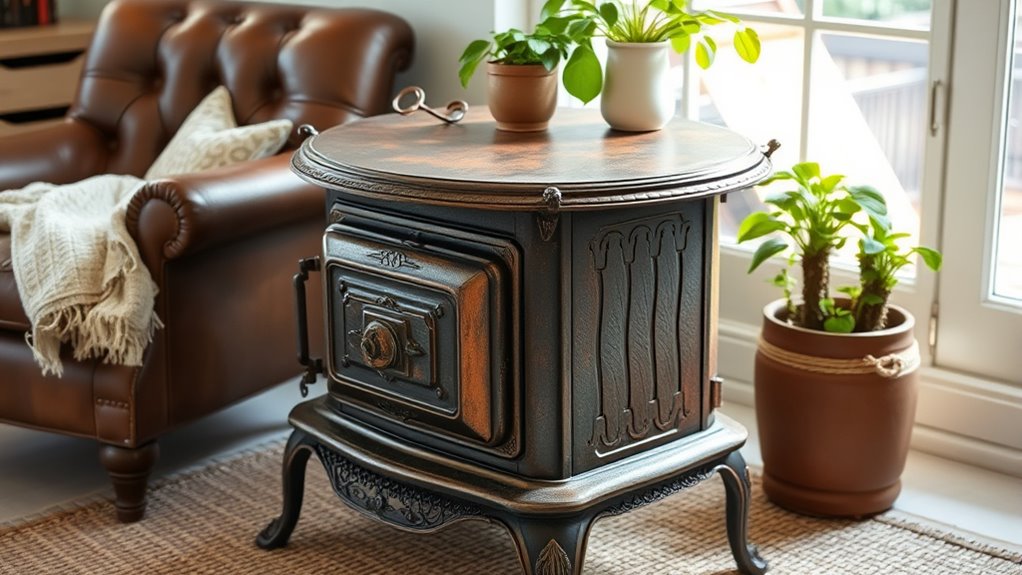
If you’ve ever come across an antique wood stove gathering dust, you know it has potential beyond its original use. Instead of letting it sit unused or scrap metal, you can upcycle it into a unique piece of furniture that adds character to your space. The process begins with understanding the proper restoration techniques to guarantee the stove is safe and visually appealing. First, you need to thoroughly clean the stove, removing rust, dirt, and old paint. Using wire brushes, rust removers, and possibly a power washer can help eliminate years of grime. Once clean, you should inspect the stove for any structural damage or weak spots. Welding or reinforcing parts might be necessary if the metal has become brittle or cracked over time. Sandblasting can give the surface a smooth finish, preparing it for a new coat of paint or sealant.
However, before diving into aesthetic upgrades, safety considerations must be your top priority. Antique stoves often contain residues or materials that could be hazardous, such as old paint with lead or internal components that aren’t safe for indoor use. You should always wear protective gear, including gloves, masks, and goggles, during restoration. If you plan to use the stove as a functional piece—say, as a fireplace or heater—you need to have it inspected by a professional to assure it meets current safety standards. Removing any remaining creosote or soot, sealing off internal chambers, and ensuring proper ventilation are critical steps. If the stove is purely decorative, it still needs to be stabilized and sealed to prevent rust or deterioration over time. Additionally, understanding the headphone jacks involved in your safety gear, like Bluetooth or wired options, can enhance your working experience by allowing you to listen to music or instructional videos hands-free as you restore.
Once safety measures are addressed, you can proceed with customizing the stove into furniture. Painting or coating it with heat-resistant finishes can give it a fresh look, while adding legs or a top surface transforms it into a table or stand. You might also incorporate shelving or storage compartments inside or around the stove to enhance its functionality. The key is to balance aesthetics with safety, ensuring that your upcycled piece is both beautiful and secure. When finished, your antique wood stove can serve as a striking table, a unique centerpiece, or even a conversation-starting storage unit. Upcycling takes patience and care, but with the right restoration techniques and safety considerations in mind, you turn a forgotten relic into a functional and stylish piece that honors the past while enriching your present space.
Frequently Asked Questions
How Do I Ensure Safety During the Upcycling Process?
To guarantee safety during the upcycling process, always wear appropriate safety gear like gloves and goggles to protect yourself from sharp edges and dust. Make sure you have proper ventilation precautions in place, such as working outdoors or in a well-ventilated area, to avoid inhaling fumes or dust. Take your time, follow safety guidelines, and stay alert to prevent accidents and ensure a safe, enjoyable project.
What Tools Are Necessary for Restoring an Antique Wood Stove?
You need essential tools like a wire brush and sander to reveal the stove’s true beauty. Restoration techniques demand precision, so grab screwdrivers, pliers, and a paint scraper for stubborn grime. For antique preservation, use rust remover and high-quality paint. Don’t forget safety gear! With the right tools, you’ll uncover the stove’s charm, transforming it into a stunning, functional piece—just wait until you see the final result.
Can I Customize the Design to Match Modern Decor?
Yes, you can customize the design to match modern decor by blending the antique stove’s charm with sleek, contemporary elements. You might paint it with bold or neutral colors, add minimalist hardware, or incorporate glass and metal accents for a modern aesthetic. Focus on design integration by balancing vintage details with clean lines, ensuring the piece complements your space seamlessly while preserving its unique character.
What Are the Best Materials to Refurbish the Stove?
Think of refurbishing your stove as giving it a fresh new suit. You should choose heat-resistant paint for the exterior, ensuring durability and safety. For hardware, opt for rust-resistant options like brass or stainless steel to add a touch of elegance and longevity. These materials will protect your piece and help it blend seamlessly with your modern decor, turning an old stove into a stunning, functional focal point.
How Do I Prevent Future Damage or Deterioration?
To prevent future damage or deterioration, you should apply protective coatings like sealants or rust inhibitors to shield the wood stove surface. Keep it in a climate-controlled environment to avoid moisture and temperature fluctuations that can cause rust or warping. Regularly inspect the piece, clean it gently, and touch up protective coatings as needed. Proper climate control and protective coatings are key to maintaining your upcycled furniture’s beauty and durability long-term.
Conclusion
So, who would’ve thought that turning an antique wood stove into furniture could breathe new life into something once destined for the attic? It’s amusing how what’s deemed outdated or broken can become a stylish statement piece—proof that even old appliances can find a new purpose. Sometimes, the best upcycles come from the most unlikely sources. After all, what’s more charming than giving a vintage relic a chance to serve yet another purpose?




